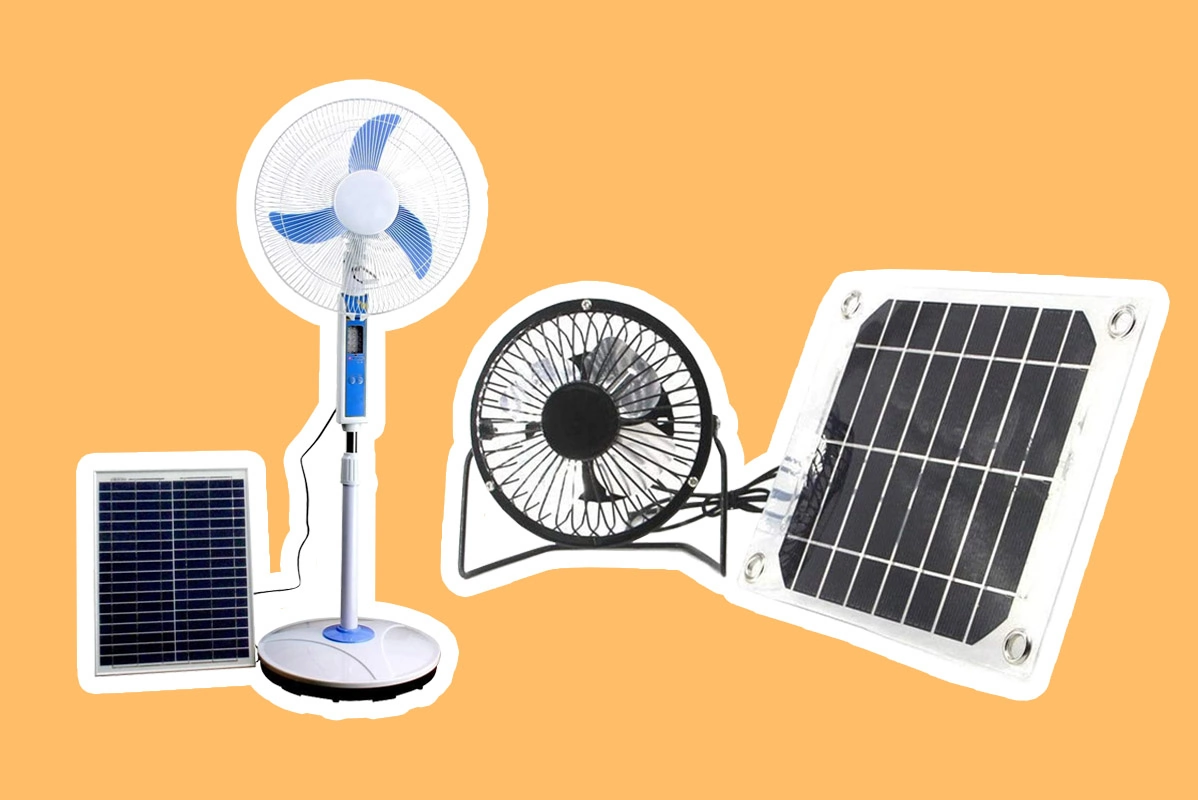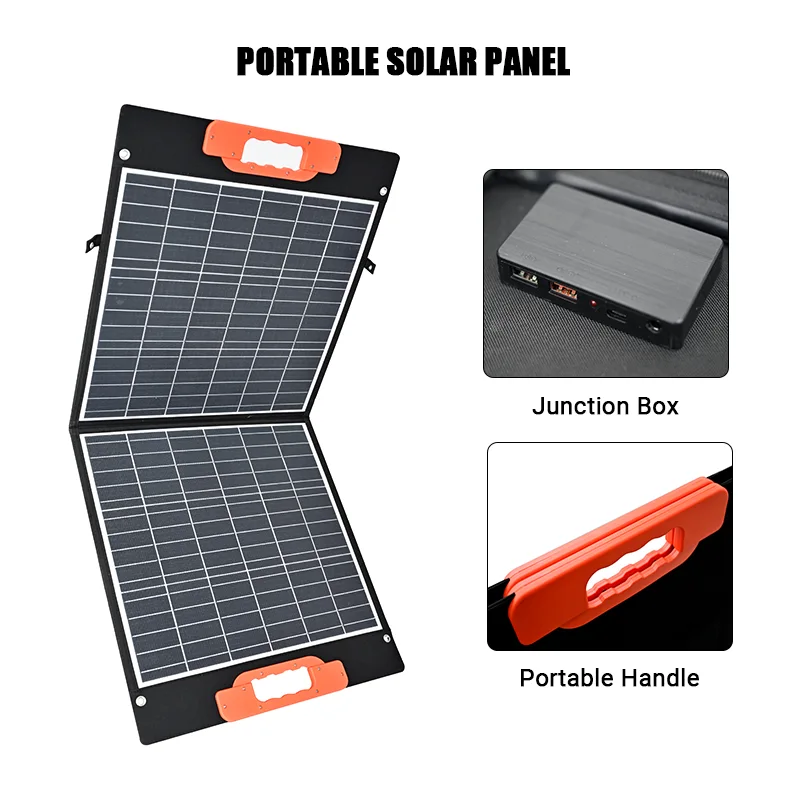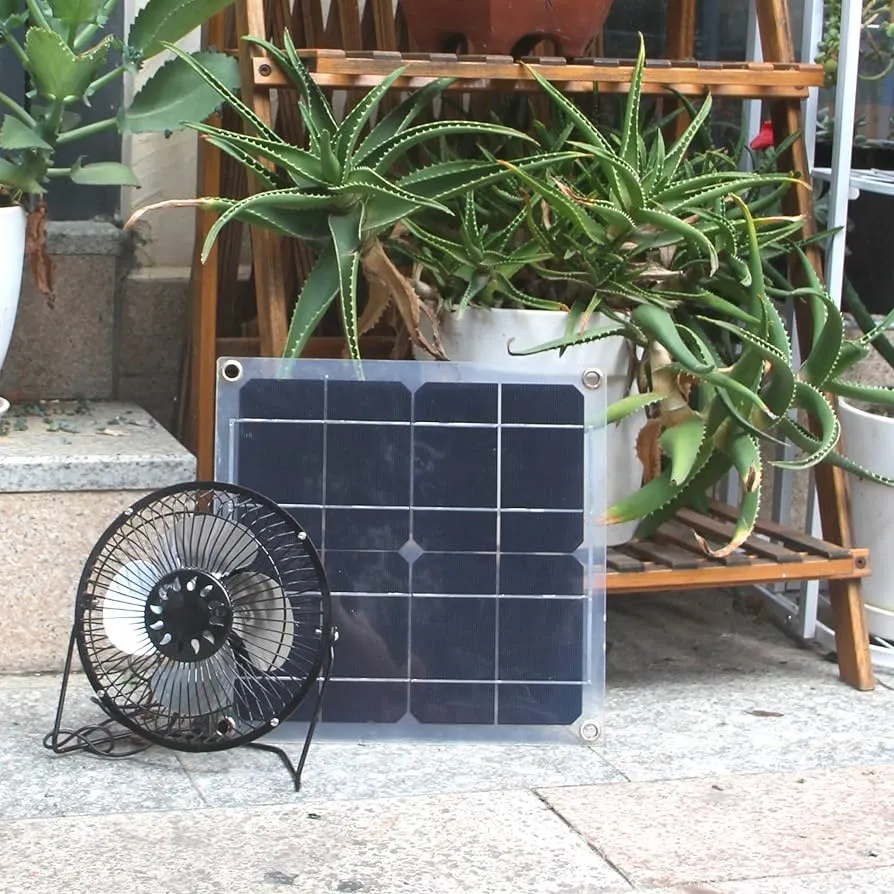Keeping your residence cool in the summer is crucial. When many people think about comfort during the hot days and nights of summer, they think about maintaining effective air conditioning. Solar fans can make most homes more comfortable by eliminating excess heat and reducing energy costs.
The standard electric fan on the market is 50W and needs to be left on for long periods to keep a room cool in the summer heat, which is a big expense on your electricity bill.
This page describes what a solar fan is, how it works, and a comparison between solar fans and solar panels for fans. For charging fans and other household appliances, we recommend Sungold solar panels, especially the Winner Bag series with a maximum power of 200W, which are quiet, clean, and easy to move around.
What is A Solar Powered Fan?
Off grid camping, living off the grid, and working in a solar powered greenhouse or workshop are situations where a fan is needed but there is no electrical outlet nearby. Solar fans come in a variety of sizes and designs, but they all use the sun’s energy to provide a cool breeze on hot days. Smaller fans are designed to be carried on summer hikes, while larger fans are used to mount on the roof to cool a large room or attic.
Your choice of solar powered fan depends on where you intend to use it. If you are looking for a personal fan, there are a variety of portable fans that you can use while camping, walking, or lying by the pool.
Alternatively, there are fairly large-sized solar fans that are designed to cool entire rooms in a building. These fans are usually specified in terms of the square footage they cover as well as the airflow (in cubic feet per minute) they produce.
How Solar Power Fan Work?
Similar to traditional fans, rechargeable solar fans function in a similar way. Solar panels are used to generate electricity. Solar energy is converted into electricity through the use of solar panels. While some solar fans come with rechargeable batteries, many solar fans are powered only by the DC electricity generated by the solar panel.
The solar panel charges the fan’s battery, which powers the fan. If the battery is not fully charged, the fan may spin more slowly or stop working altogether. For this reason, it is important to place the solar panel in a location where it will receive plenty of sunlight.

How Many Watts Do Different Fans Use in A Year?
There are several factors that come into play when trying to determine how much electricity a fan uses in a year. The amount of time the fan runs in a year and the wattage of the fan are two of the most important. To determine an accurate number, you must first find out the wattage of the fan. The wattage is usually printed on the fan motor or found in the product specifications. The wattage is a measurement of the amount of energy consumed by the fan while it is running.
Once the wattage has been determined, the number of hours the fan runs in a year must be calculated. This may vary depending on the temperature and the amount of air circulation required.
| Spec Unit: W | All Fans | Ceiling Fan | Tower Fan | Box Fan | Table Fan |
| Low Wattage Average | 7 | 4 | 44 | 47 | 17 |
| Max Wattage Average | 39 | 31 | 56 | 73 | 43 |
| Common Wattage | 33 | 33 | 54 | 100 | 40 |
| Lowest Wattage | 1.5 | 2 | 6 | 5 | 1 |
| Highest Wattage | 220 | 100 | 110 | 220 | 110 |
In general, it is safe to assume that the fan will run 8 hours per day, 5 days per week, or a total of 2,080 hours per year.
Once you have determined the operating hours and wattage, you can calculate the amount of electricity (kWh) the fan will use in a year. To do this, multiply the wattage by the hours per year.
For example, if the fan uses 100 watts and runs for 2,080,
it will use 208,000 kWh (100 x 2,080) per year.
Therefore, the amount of electricity a fan uses in a year depends greatly on the wattage of the fan and the amount of time it runs. Determining these two factors is very important to accurately calculate the amount of electricity used by a fan in a year.

How Much Does It Cost to Run A Fan?
When operating a fan, the cost of electricity may vary depending on the type of fan and its power rating. Generally, most standard fans are rated at 25-75 watts, and ceiling fans usually consume more power than standard fans. On average, electricity costs about 10 cents per kilowatt hour (kWh) in the United States. So, if you run a 50-watt fan for 8 hours a day, your monthly electricity bill is about $0.12. This means that it will cost you no more than 48 cents a month to run the fan.
To calculate the cost of running the fan for a full year, you need to multiply the monthly cost by 12 months. So, for a fan that consumes 50 watts, running the fan for 8 hours a day will cost you no more than $5.76 per year. Of course, this cost may vary depending on your local electricity prices, the wattage of the fan, and the amount of time it is used.
Sungold Solar Panels for Fan
A cooling system consisting of a fan at its core not only plays a vital role in circulating air in a room but also speeds up air circulation when camping outdoors, allowing for a more comfortable outdoor lifestyle.
Since solar power fans (also known as fan solar panels) are highly dependent on direct sunlight, position and angle of the solar panel, there are many limitations to their use. Many outdoor enthusiasts began to use portable solar panels for fan charging, solar panels for fans can be adjusted at multiple angles while driving the fan can also charge other electronic devices or storage batteries, multi-purpose, more versatile.

Sungold Solar is the most popular off-grid solar brand, specializing in sustainable solutions for outdoor, camping and off-grid. The main products are mainly portable solar panels, folding solar panels, and portable charging bags.
Winner Bag is a foldable and light solar panel weighing 7.7 kg. The lightweight design is also splash-resistant, perfect for all your outings and adventures. Due to the user-friendly handle and the possibility to fold the panel, the solar panel can be easily carried and set up.
Solar Powered Fan Vs. Solar Panels for Fan
However, compared with solar panels for fan solar powered fan, the solar panels are already combined and installed with the fan at the factory, which eliminates the need for wiring or other troubles, and makes it more difficult to troubleshoot and repair them one by one in the event of a malfunction.
The overall price of purchasing the fan and solar panel separately will be cheaper than buying the solar power fan directly, and the solar panel has high compatibility and adaptability, which can be used with other devices, so you can harvest more combinations and more solar devices, such as solar lantern, solar monitoring, solar refrigerator, solar air conditioning and so on.
Sungold solar panels for fan can help you save money on your utility bills, as long as there is sunlight, the solar panels can collect and convert it into electricity, and the use of the electricity generated is completely free of charge.The Winner Bag has been designed with multiple charging ports of various types in the carry handles, so simply connect the wiring to your device and it will be ready to be put into use straight away.
With a high output of 200w and an efficiency of up to 22%, the Winner Bag has more space to absorb more sunlight when fully extended, so when the sun is shining it can generate more power for other devices other than fans, making it more versatile and practical.
| Solar Fan Vs. Solar Panels for Fan:Pros & Cons | ||
| Types | Pros | Cons |
| Solar Powered Fan | -Easy to use
-Space saving -Convenient to carry |
-Not flexible enough to use
-Higher price -Difficult to repair and maintain |
| Solar Panels for Fan | -Many features, can be combined with other devices
-Good value for money -Easier to upgrade or replace |
-Complicated to assemble and install
-Takes up more space |
The Pros & Cons of Solar Fan

The solar panel charges the fan’s battery, which powers the fan. If the battery is not fully charged, the fan may spin more slowly or stop working altogether. For this reason, it is important to place the solar panel in a location that receives plenty of sunlight.
Residents living in areas with a lot of cloudy days and homes with shade trees should consider purchasing a solar-powered fan with a backup power source so that they can continue to use the fan on cloudy days. If not, you will need a conventional electric fan as a backup. When choosing a solar fan, you must first determine where the solar panels will receive the most sunlight and then where the fan will be located.
Pros:
- Solar fans can help keep your home fresh. In warmer climates such as Florida, heat buildup in the attic can damage the roof, insulation, and structural integrity of the home.
- Summer humidity and moisture can promote the growth of fungus and mold in your attic, as well as damage the structural support of your home.
- Solar fans use solar energy without electricity, which is good for the environment. Your solar attic fan as a renewable energy source will help you save money and reduce your carbon footprint.
- Solar energy, also known as photovoltaic power, used by solar fans is free and can also help reduce utility bills by exhausting hot air from the fan.
Cons:
- Solar fans are relatively new and more expensive than traditional fans.
- In most homes, two solar attic fans are needed to circulate the necessary air and save energy.
- Solar fans require direct sunlight because the sun is their energy source.
- Some solar fans require charge controllers, inverters, and batteries to be used at night.
- The right cables need to be used to connect you to the solar fan. It is ideal for keeping them relatively close together because too long of a cord can create a tripping hazard.
- Solar attic fans are becoming increasingly popular, but solar ceiling fans and window fans still need to be available.
FAQ
| Can the fan be connected directly to the solar panel without an inverter?
Yes, but the fan must use 12V power supply. There are 12V fans available in the market today. Some companies are also producing inverter fans with inbuilt inverter technology. Some inverter fans also have dual inputs i.e. 220V AC and 12V DC. 2. Can solar fans be used at night? Since solar fans rely on sunlight to generate electricity, they cannot be used directly at night. However, solar panels can be used to charge batteries or energy storage devices such as the Anker PowerHouse 767 during the day and then power the fan at night. By storing the excess energy generated during the day, the solar fan can continue to run at night. Is a solar fan worth buying? The answer is: absolutely! Solar fans cost between $300 and $500, with professional installation costing an additional $100 to $150. With the long-term enjoyment you can get from this small-scale air circulation cooling system, a solar fan may be an affordable and sustainable solution for the long term. Do some fans have power saving features? Yes, some fans have built-in power saving features such as timers and motion sensors to help reduce electricity usage. Depending on the model, the fan may turn off automatically when it detects that the room has been unoccupied for a certain amount of time. Other features may include energy-efficient motors, adjustable speed settings and remote control. By using these features, the energy consumption of the fan can be significantly reduced. In addition, ceiling fans with LED lights use less energy than non-led ceiling fans. Does the speed of a fan affect its power consumption? Yes, the speed of the fan affects its power consumption. As the speed of the fan increases, it takes more energy to run. When the fan is running at full speed, it will consume more power than when it is running at a lower speed. Also, higher fan speeds increase airflow, which cools the room more efficiently. To minimize electricity usage, it is important to adjust the fan speed to the speed required to achieve the desired cooling. |










